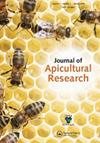Sustainable development outlooks to subsistent apiculture in a transition: the case of Ethiopia
IF 1.8
4区 农林科学
Q2 ENTOMOLOGY
引用次数: 0
Abstract
Abstract Since the inception of the term sustainable development at the end of the 20th century as a reconciliation between the needs for socio-economic development and environmental protection, various concepts and production systems have been initiated to address demands for food and other products. These include organic agriculture and sustainable intensification, which vary with the sector and local context. Here, we provide outlooks to sustainable development aspects of apiculture focusing on a subsistent beekeeping country that tries to transform – Ethiopia. For this, a review of sustainable agriculture and apiculture including national reports from 2005 to 2020 was conducted. The major points are: (1) Annual honey production improved from 25,000 tons in 2005 to 150,000 tons in 2020 by increasing the number of honey bee colonies from 4.2 to 7 million (65%) and through the provision of higher yielding frame hives (17.9 kg per hive per year) and top-bar hives (13) compared to fixed-comb traditional hives (9.31). (2) Average honey yield of top-bar hives was 40% higher than that of traditional hives. (3) Export volume grew from 274 tons in 2009 to 481 tons in 2016. (4) Development initiatives focused on the introduction of frame hives (3%) compared to top-bar hives (1%). However, the traditional beehives that involve unfriendly management remained dominant (96%). Popularization of the locally developed top-bar hives can provide sustainable enhancement of honey production to supply to the domestic market without dependence on certification of a third country and foundation combs patterned by imported casting molds based on European bees.可持续发展展望转型中的自给养蜂业:埃塞俄比亚的案例
摘要自20世纪末可持续发展一词出现以来,作为社会经济发展需求和环境保护之间的调和,人们提出了各种概念和生产系统来满足对食品和其他产品的需求。其中包括有机农业和可持续集约化,它们因部门和当地情况而异。在这里,我们提供了养蜂业可持续发展方面的展望,重点关注一个试图转型的生存养蜂国家——埃塞俄比亚。为此,对可持续农业和养蜂业进行了审查,包括2005年至2020年的国家报告。主要要点是:(1)通过将蜂群数量从420万个增加到700万个(65%),并通过提供产量更高的框架蜂箱(17.9 (2)顶杆蜂箱的平均产蜜量比传统蜂箱高40%。(3) 出口量从2009年的274吨增长到2016年的481吨。(4) 开发计划的重点是引入框架蜂箱(3%),而顶部条形蜂箱(1%)。然而,涉及不友好管理的传统蜂箱仍然占主导地位(96%)。推广当地开发的顶级蜂箱可以持续提高蜂蜜产量,供应给国内市场,而无需依赖第三国的认证,也无需依赖以欧洲蜜蜂为原型的进口铸造模具制作的基础梳子。
本文章由计算机程序翻译,如有差异,请以英文原文为准。
求助全文
约1分钟内获得全文
求助全文
来源期刊
CiteScore
4.80
自引率
10.50%
发文量
111
审稿时长
6-12 weeks
期刊介绍:
The Journal of Apicultural Research is a refereed scientific journal dedicated to bringing the best research on bees. The Journal of Apicultural Research publishes original research articles, original theoretical papers, notes, comments and authoritative reviews on scientific aspects of the biology, ecology, natural history, conservation and culture of all types of bee (superfamily Apoidea).

 求助内容:
求助内容: 应助结果提醒方式:
应助结果提醒方式:


